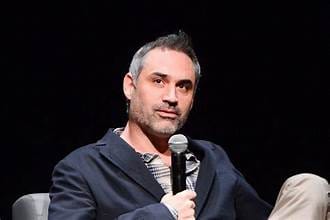Alex Garland's Cinema of Entrapment and Escape

The British director has shown Americans in circumstances that make scenes of horror personal; herewith, a look at his strategies.
Recently in this space I discussed (“Civil War" Is here—and we’re living it”) Alex Garland’s recent film about an America wrenched into anarchy and discord. It’s the biggest hit the virtuous A24 production company has ever had and, keeps ticking towards meeting its $50m cost, in part because it eschews pitting red versus blue, Trumpian populism versus democracy. As epitomized by an encounter with Jesse Plemons’ white nationalist character, the film probes evil through the eyes and camera lenses of a quartet of journos.
The film also serves as another plank in building what’s now clearly a sustained and important body of work built by writer-director Garland. And, with apologies if the above headline sounds like someone’s senior thesis, it seems time to consider Garland's strategy for rolling out hefty toipics that somehow stay compellingly watchable.
A pretty obvious key that’ss easier said than done is his craftiness at putting us in the emotional space of his protagonists as they live through their brain-busting crises and quandaries, but never quite losing us on the skidding turns of his specialized go-to's: pathogens, sci-fi sucker-punches, and particle physics. In ace cinematographer Rob Hardy he has a mood-stoking visual partner.
Whether it’s his screenplay for Danny Boyle’s 2002 “28 Days Later,” as a young Cillian Murphy flees the swirling tide of an epidemic of chimpanzee rage (well before Covid’s pangolin panic), or the nerve-shredding anxieties of Domhall Gleeson while is effectively imprisoned by smarmy tech incel Oscar Isaac in 2014’s “Ex Machina” (directed by Garland from his own Oscar-nominated script), or the desperation of a quintet of women scientists trapped in “the Shimmer” of a Southern coastal swamp after an otherworldly event in 2018’s “Annihilation,” Garland’s heroes—or more likely, heroines—must strive for escape by using their resourcefulnesss, and often, a teeth-gritted defiance.
In his 2020 streaming venture “DEVS” we shared the agonies of a young software ace (Sonoya Mizuno’s Lily) as she’s enmeshed in a a crackpot, world-changing quantum AI scheme, in the claustrophobic simulated metaverse of Nick Offerman’s Zuck/Musk figure. True to form, the filmmaker’s endangered characters are confined in distressing spots while embroiled in events they didn’t see coming. They stand in for us as we navigate a world of surveillance and unkillable subscriptions, even as we dodge intrusions from our Big Brothers, the tech lords.
Related to the entrapment motif and running down the spine of almost every Garland project—like his editorial cartoonist father, he melds involving visuals with razor-edged thinking–is a belief that we must push for our higher moral precepts to prevail—or sometimes die trying.
Even more confined in steady near-terror is Jessie Buckley in 2022’s “Men,” as an increasingly horrific array of lookalike males who all—save for the abusive husband who haunts the story–unnerve and disgust us as they track her through loamy fields to–and within– the confines of a would-be bucolic retreat. She’s isolated from society in a country house that might have beam charming but is peopled by demons that make Uncle Monty’s siege in “Withnail and I” look like a genuine holiday.
Most recently, with “Civil War,” Garland sends us, often crammed inside an SUV with his journo quartet, down a deadly corridor of ruined American highways. The foursome unites in their loyalty to the task of recording the violent pilgrimage’s near-meaningless events, prisoners of their own dedication.
The best moments, then, in sequence:
“The Beach” was the young (then age 25) Garland’s malediction to the idea of an idyllic second post-Vietnam decade of good times on the Hippie Highway– a trail that left out Europe and headed for spots like Goa, Katmandu, and for a time, the film’s Gulf of Thailand setting.
As a self-described “backpacker” in his youth, it was logical he would find his way to Thailand, and then on to a spot about as remote as most travelers then dared, the island of Koh Samui. (I made the same journey, three times, but there’s room for that memory anon.)
By the time Garland’s inveiglingly creepy beachside thriller came out in 1996, our set had moved on to Koh Pha-ngan (and the hardier ones, beyond that), for the same reason Leo DiCaprio’s character sought a place to go native in the movie Danny Boyle made from Garland’s novel-into-script. The search was for a place where you go, said narrator Richard, “Once you cross the ocean and cut yourself loose, looking for something more beautiful, something more exciting, and yes, I admit, something more dangerous.”
For that aspiration, Tilda Swinton, with her spooky side-eye, served as the ideal “I am the danger” threat . (By the time we meet Swinton’s Sal, Richard is effectively caught in the cult she rules by force of will and casually cruel disciplines.)
Over time, Garland as both scenarist and director would become anyone but a provider of happy outcomes, but DiCaprio’s Richard he finds insight by tempting death. In fact, he still believes in paradise: ”Its’s not some place you look for…it’s how you feel for a moment in your life when you’re part of something. And if you find that moment, it lasts forever.”
After shrinking away from the sudden fame his novel and screenplay brought, Garland stewed creatively for some time before bending towards something much grittier—for a George A. Romero fan, what else but a zombie movie?
Garland’s obvious familiarity with deploying a schmear of cinematic evil led to director Danny Boyle picking up on his screenplay for ”28 Days Later,” an idea that “began as a gag”--in part as “a reaction, because I felt [“The Beach”] lacked aggression.” He would become a fine match for Boyle, whom Garland found to have “a terrific instinct towards viscerality and compulsion”. Such influences became the hallmarks of a budding auteurism Gardland would later downplay. (He'll write at least one piece: he and Boyle, having stayed at arm’s length from the “28 Weeks Later” sequel, are prepping a collaboration on “28 Years Later,” to be released in June 2025 with post-“Oppenheimer” Murphy on board as a producer and possibly onscreen.)
As physicist/astronaut Robert Capa, Murphy joined the duo to stand at the center of the ensemble clustered together for a space mission (to re-set a chilling sun) in 2007’s “Sunshine”, script by Garland. Directed by Boyle, who would declare the shoot “spiritually exhausting,” it recalled Ridley Scott’s “Alien” but muffed the ending.
It also ushered in Garland’s professional slack period, with the scripts for 2010’s “Never Let Me Go” a perhaps too monotone (his word) adaptation by Garland of Ishiguro’s novel, which one critic summed up as “enervating,” and then “Dredd,” an action slam-fest that Garland’s script—and attempts to doctor in post—did little to elevate.
But Garland’s chef d’oeuvre as writer-director was on its way. “Ex Machina”’s core quartet revolves around Isaac’s Nathan, a summit-level tech bro, as he drives AI towards a queasy-making sexual frontier. We can’t turn away as the film’s two dawningly self-intersted females and Gleeson’s (at first) hapless cyber-nerd struggle in their incarceration by advanced biometrics—until a vividly bloody finale.
2018’s “Annihilation” begins with a marriage broken by a dawning world catastrophe—Oscar Isaac came back for Garland as Kane, a special ops sergeant gone missing, leading stricken spouse Natalie Portman to insert herself in a quixotic rescue mission. It’s a mark of Garland’s knack as chief entertainer-in-disguise that automatic weapons and canny moves are the only way out of mutating horrors.
The impact of the pandemic slowed Garland right along with everyone else, until release April of 2020’s streamer “DEVS”. The key driver of events is watching Mizuno’s Lily fight to claw back command of (to oversimplify in a way Garland wmight not) her own free will.
To present day, then, and "Civil War". Both Callie Spaeny as precocious conflict shooter Jessie and Stephen McKinley Henderson as avuncular reporter Sammy (with his own action beat that pays off big) win our investment in them. In time, Kirsten Dunst’s Lee becomes the film’s symbol of traumatized but readys bravery– and hard-won glory, of a sort. Said Garland recently, “I miss reporters as the source of factual information of what’s happening in the world…"
In the bigger picture, he recently told Vulture, “It feels like my last four films as a director are a sequence of films which are following a sequence of thoughts. 'Civil War,' I think, as far as I can tell, ends that sequence.”
So, as much as we might wish for more, sooner, it seems that for now the reluctant auteur has planned his own escape.
We’ll see.


Comments ()